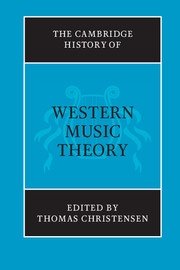Book contents
- Frontmatter
- Introduction
- PART I DISCIPLINING MUSIC THEORY
- PART II SPECULATIVE TRADITIONS
- PART III REGULATIVE TRADITIONS
- A Mapping tonal spaces
- B Compositional Theory
- C Time
- D Tonality
- 23 Tonality
- 24 Rameau and eighteenth-century harmonic theory
- 25 Nineteenth-century harmonic theory: the Austro-German legacy
- 26 Heinrich Schenker
- PART IV DESCRIPTIVE TRADITIONS
- Index of authors
- Index of subjects
- References
26 - Heinrich Schenker
from D - Tonality
Published online by Cambridge University Press: 28 March 2008
- Frontmatter
- Introduction
- PART I DISCIPLINING MUSIC THEORY
- PART II SPECULATIVE TRADITIONS
- PART III REGULATIVE TRADITIONS
- A Mapping tonal spaces
- B Compositional Theory
- C Time
- D Tonality
- 23 Tonality
- 24 Rameau and eighteenth-century harmonic theory
- 25 Nineteenth-century harmonic theory: the Austro-German legacy
- 26 Heinrich Schenker
- PART IV DESCRIPTIVE TRADITIONS
- Index of authors
- Index of subjects
- References
Summary
Long after his major writings on harmony, counterpoint and analysis began to appear, Heinrich Schenker (1868–1935) remains one of the most important and influential theorists in the history of Western music. His achievements have often been compared to those of eminent thinkers of his age working in other fields, e.g., his Viennese compatriots Sigmund Freud in psychology and Albert Einstein in physics. His influence, modest (though not negligible) in his own lifetime, has grown steadily since the middle of the last century and shows no signs of abating. Already a paradigmatic figure in North American universities by the 1970s, he has since exerted a powerful influence in British and, more recently, European academic circles. Indeed, the interest shown in his life’s work is, in some respects, comparable to that of some of the twentieth century’s leading composers, and in this respect his reputation as a theorist is unequaled.
That which is called “Schenkerian theory” is a complex set of regulatory principles that were initially intended to explain the tonal music of the eighteenth and nineteenth centuries; it is at the same time a synthesis of many traditions, embracing Fuxian counterpoint, the thorough-bass teaching of Carl Philipp Emanuel Bach and late nineteenth-century harmonic theory. It is at once a sophisticated explanation of tonality, but also an analytical system of immense empirical power. Schenker’s ideas and work touch on, or have implications for, virtually every topic addressed in this volume.
This chapter includes a synopsis of Schenker’s life and works, an explanation of the rudiments of his theory, remarks on its historical background, and a survey of its reception both as a pedagogical tool and as a basis for further investigation of a wide range of music.
- Type
- Chapter
- Information
- The Cambridge History of Western Music Theory , pp. 812 - 844Publisher: Cambridge University PressPrint publication year: 2002
References
- 6
- Cited by



